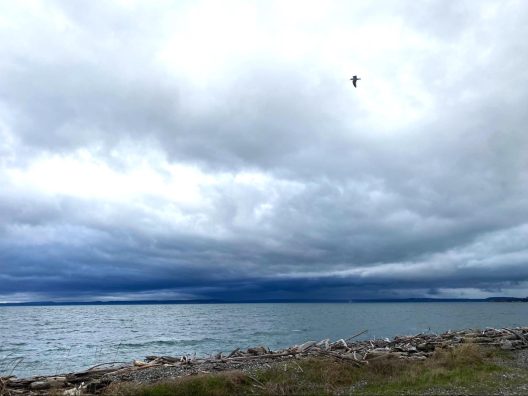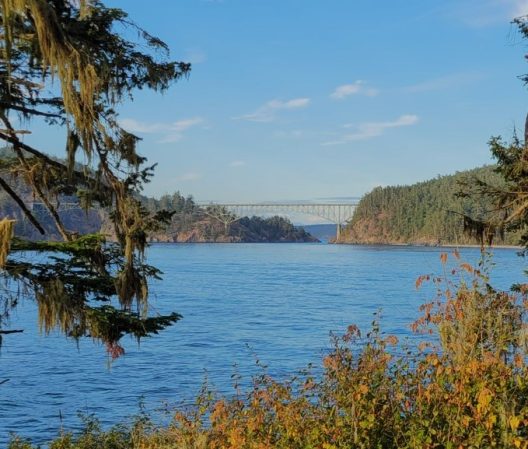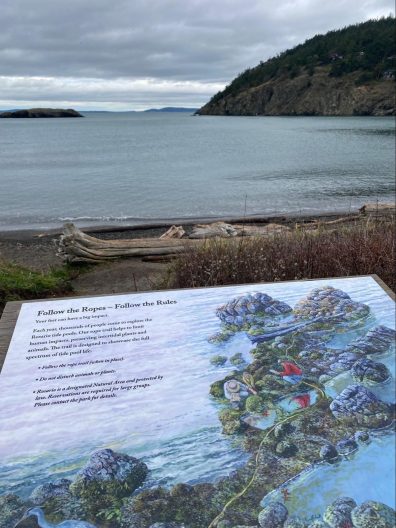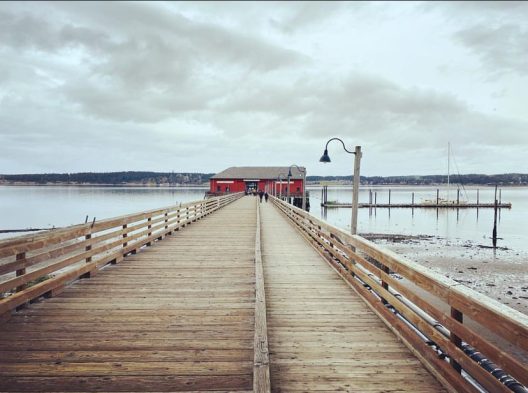Wandering Around Whidbey: The Best Places to Explore on Whidbey Island this Winter
As the excitement and relaxation of the holiday break comes to an end, and students are drawn back to weekly to-do lists, assignments, and research, I’m found searching for a new weekend adventure to break up the quarter’s hustle and bustle. I find myself eagerly brainstorming this adventure, one that is preferably outdoors, gets me moving to feel better about the holiday sweets consumed, and is a much-needed break within a busy winter quarter.

Having been born and raised in the Evergreen State, I was lucky to spend much of my childhood on the rocky shores of Puget Sound’s narrowest and largest island, Whidbey Island. Whidbey sits just north of Seattle beneath the looming shadow of the Olympic mountain range and peninsula and is surrounded by the greater Salish Sea. My grandfather’s naval career had his family stationed in Whidbey’s northern hub, Oak Harbor, some 50 years ago, and now, my parents call the island’s western shores of Coupeville home.
Anticipating the hectic nature of winter quarter and yearning for a new weekend adventure, I wanted to explore my love of Washington’s green and blue spaces while sharing with SMEA’s like-minded community the best ways to experience the outdoors of the Pacific Northwest this winter – so, join me in heading to Whidbey Island!
The imposing Deception Pass Bridge establishes an intricate connection between the northern tip of Whidbey Island, Fidalgo Island, and nearby maritime hub, Anacortes. Originally constructed by the Civilian Conservation Corps in 1934, this hulking evergreen-colored bridge is a Washington wonder and has been registered on the National Register of Historic Places. I suggest a stroll along its railings for stunning aerial views of the Strait of Juan de Fuca. But enough about the bridge itself, let’s talk about what lives beneath the bridge—and it’s no troll!

Deception Pass is a popular summer hot spot for hiking, camping, biking, boating, and fishing. The currents beneath the Deception Pass Bridge are swift and strong enough to challenge even the most experienced sailors, and campers travel from far and wide to sleep beneath the site’s towering Western red cedars. Having camped at Deception Pass every year for the last 30, I promise that there is always a new beach to explore or path to hike within this gorgeous area. Even when the summer sun melts away and temperatures drop a bit low for some campers, Deception Pass still has so much to offer.
Situated on the north side of the bridge is Rosario Head, home to staggering views of the Strait of Juan de Fuca and nearby San Juan Islands, both short and more tedious hikes, the perfect spot for a family picnic, and my personal favorite: the Rosario Beach tide pools. Whenever I drive through the north side of the island, I make sure to stop at the pools (especially at low tide) to check out the elusive sculpin, tiny green sea anemones, and impressively large chitons. There are even naturalists on-site to help guide those looking to learn more about Washington’s tide pools while sticking to a clearly marked path to avoid damage to the pools’ more vulnerable areas. After my quick walk through the pools, I head up to Rosario Bluff to sit and take in the views of the Strait and nearby San Juans. If you’re lucky, you’ll spot a harbor seal or northern sea otters floating through the coastal forests of kelp. My advice: bring a snack and water, and stay a while—transient killer whales have been known to swim through the bridge, so you just may see them on the horizon!

After your stop at Rosario Head, you can start moving south and either stop at Bowman Bay for more beachside exploring like a hike around Lottie Bay, or head over Deception Pass Bridge where you’ll officially step foot on Whidbey Island itself. The south side of the bridge is home to Deception Pass State Park, hikes to breathtaking viewpoints atop Goose Rock, or walks along the park’s beach where you can skip a rock or two. If you’re more cold tolerant than me (which, let’s be honest, isn’t hard), pitch your tent, unroll your sleeping bag, and stay the night. Camping at Deception Pass truly can’t be beat.
Now that you’ve gotten your north Whidbey fix, you’ll find yourself driving south past Oak Harbor along Highway 20 towards my favorite spot: Coupeville. Centrally located on the island, Coupeville sits within the Ebey’s Landing Reserve along a popular shellfish area, Penn Cove, historic home to the Lower Skagit people.
Coupeville is the perfect place to stroll through, grab a bite of fresh seafood, and scan the ebbing tide for marine life or master fishermen, the great blue heron, or even more whales as you roam along the cascading bluffs of Fort Ebey State Park. If birding is your thing, head to Crockett Lake to search for migratory birds like sand-pipers or plovers or even a common bald eagle sighting (often with a fish or two dangling from its talons)! Walkers or hikers of all skill levels can find a spot to stroll through Ebey’s Landing and look out across driftwood beaches towards the looming Olympic Peninsula or explore the damp barracks, ladders, and canons of historic Fort Casey. And if your interest is piqued by the ferry moving slowly across the water, you can easily walk on for a 35-minute jaunt across to the maritime center of Port Townsend. It makes for a perfect day trip to explore through the history-filled town and nearby Fort Worden.

An outdoor adventure to Whidbey Island isn’t complete without walking along one of its driftwood beaches and admiring the intricacy of beach forts that have been built by visiting “kids” of all ages. If you brought a furry passenger, start south and stop at the Greenbank off-leash area for a stroll through the grass and another birding opportunity, and peek into neighboring Greenbank Farm. If your pup needs even more room to run, stop off at Freeland’s Double Bluff Beach before heading south to Langley!
Last stop before hitting Clinton and the ferry home is Langley, facing northeast and overlooking Camano Island and Saratoga Passage. Sitting atop bluffs and looking down upon greater Possession Sound, Langley is home to the Snohomish people and is a present-day marine life viewing hotspot—perfect for ocean lovers. Nearby shallows offer migrating gray whales a safe haven and chance to feed throughout the season. North Puget Sound gray whales, or “Sounders” as they’re known in the Salish Sea community, are a population of unique gray whales who feed on ghost shrimp in the shallows off of south Whidbey Island and Saratoga Passage. Annually, lucky onshore viewers can use the bluffs scopes and binoculars to spot these whales, either feeding, swimming near fellow baleens like the humpback whale, or being pursued by mammal-eating transient killer whales. Have no fear—if the grays aren’t in the area while you’re there, you can learn more from the Langley Whale Center after wandering through town.
At this point, in part thanks to the Pacific Northwest’s shorter winter days, you’re probably ready to head home after a day full of learning about Whidbey Island’s history and exploring all of the outdoors that the island had to offer. From strolling along beaches, keeping your eyes peeled for native marine or bird life, and hiking through the island’s dense forests of evergreens, cedars, and madronas, Whidbey Island is sure to be the perfect weekend adventure out of the city. And while I know there is so much more that the Whidbey Island outdoors has to offer, I couldn’t help but share a few of my favorites to help you explore this winter!
- Map highlighting the various stopping points throughout Whidbey Island mentioned in the story above! Photo credit: Map data courtesy of Google Maps, 2024.
- Along Langley’s waterfront, you can find both the whale bell and telescopes to aid eager whale watchers in sighting species, such as the gray whale, from the city’s shore. Photo courtesy of Elise Adams, shared with permission.

